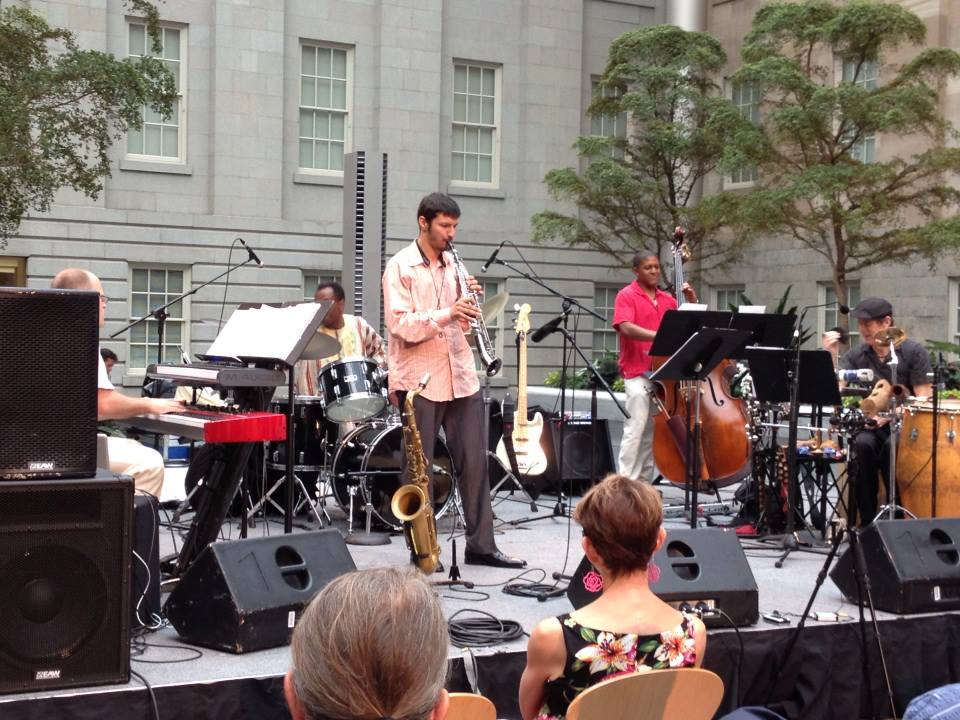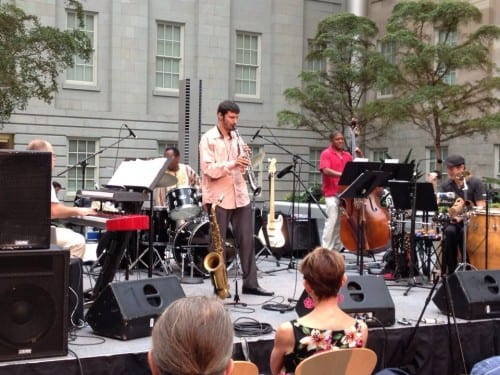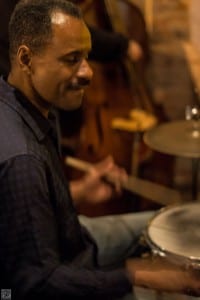Live review | The Harold Summey Quintet brings fresh life to Weather Report’s multifaceted legacy


by John Cook
CapitalBop contributor
Last Thursday brought another brilliant installment in the Smithsonian American Art Museum’s Take Five! series of free concerts, with the Harold Summey Quintet interpreting Wayne Shorter’s compositions for his 1970s fusion band, Weather Report. The show played to the strengths of two local curatorial triumphs, both organized by the presenter Bertrand Uberall: D.C.’s yearlong celebration of Shorter’s 80th birthday, and the composers series at Take Five!
On Thursday, a band featuring some of D.C.’s finest was undaunted in the face of a fairly monumental musical challenge. Shorter’s compositions are tough to realize, especially in light of the caliber of musicianship in the original bands. That Weather Report was, in many ways, several bands, with very different players and sonic signatures over nearly 15 years of activity, poses another challenge to a single set of players. They have to navigate the vast expanses between the original group’s more acoustic, open plains to a denser, heavily electrified forest.
Summey – a remarkable if unsung drummer, who won the Thelonious Monk International Jazz Competition in 1992 but never pursued a higher level of fame – did masterful work arranging Weather Report material from a variety of sources. Shorter’s compositional approach lends itself to exploration, as his remarkable melodic statements are typically wrapped in shifting dreamscapes propelled by a strong sense of movement. Summey made connections within the material, with two medleys that brought together a variety of compositions from different eras. The copyright lead sheet for “Surucucu” provided the opportunity to present a very different and previously unheard version of that classic, while other essential material for which no notation exists at all was transcribed and fully arranged by Summey himself.
The confidence and preparation of the leader and the well-rehearsed group resulted in a performance combining suitable reverence for the material with the overwhelming spirit and infectious joy of the original performances. In this way, a drummer turned out to be a fabulous vessel for the creative spark of a saxophonist-composer, bringing to life music that is now rarely heard. Though Shorter continues to blaze new trails in very different contexts, the music he’s left behind should not be forgotten. Hands like these ensure that it won’t. Summey noted that the unit hopes to further develop this project, adding more repertoire beyond the dozen pieces from this debut to future performances. Let’s hope they will.

The keyboardist Tim Whalen had the nearly impossible task of reflecting the contributions of Joe Zawinul, Shorter’s only consistent partner in Weather Report. Avoiding any doomed attempt to replicate the vast galaxies of Zawinul’s uniquely personal sonic palette, Whalen instead strove for the conceptual balance, warm harmonies and counterpoint that so informed the partnership that was Weather Report. Though Shorter was not the band’s principal songwriter, Summey’s performance demonstrated how essential his vision was to the foundation and development of electrified approaches to jazz. Summey remarked that he found his own inspiration to play drums from the music of Weather Report and Earth Wind & Fire – which, he noted, “were not that far apart” – along with that of Miles Davis (whose music Shorter also played no small part in the evolution of).
Last week’s performance was another example of why the composers series at Take Five! – a program whereby local musicians every month interpret the work of a legendary jazz composer – is so exceptional. The musicians play music that has been inspirational to them, often finding new, unperformed and unheard pieces. They often create their own meticulous arrangements, and have so far proven extremely well prepared to do justice to the intent of the originals by going where the music leads them (some pieces are faithful to the letter, others improvised or extrapolated, and thus faithful to the spirit). It provides a welcome opportunity for them to play outside their usual repertoires and spaces. The crowds are typically large and enthusiastic, as well they should be, since the playing is exceptional and the opportunity to discover – or rediscover – some of jazz’s canonical works is remarkable (and free). The enthusiasm and focus that the musicians bring often makes challenging and sometimes edgy music accessible to a diverse general audience, many of whom may have had no prior exposure to it, or the musicians involved.